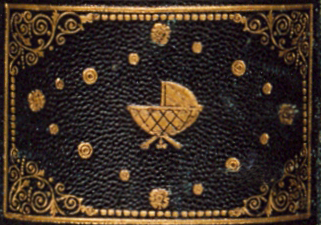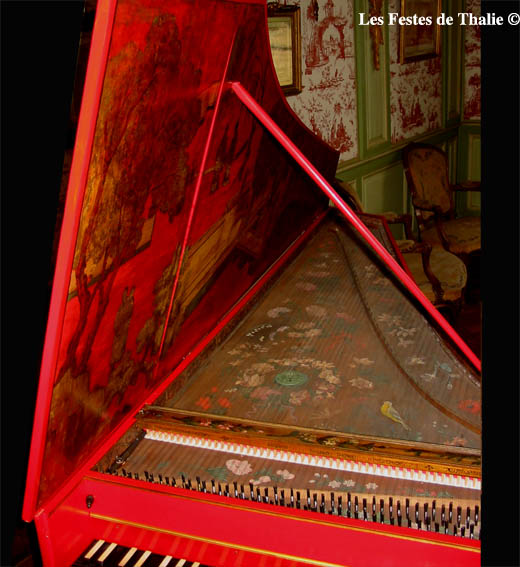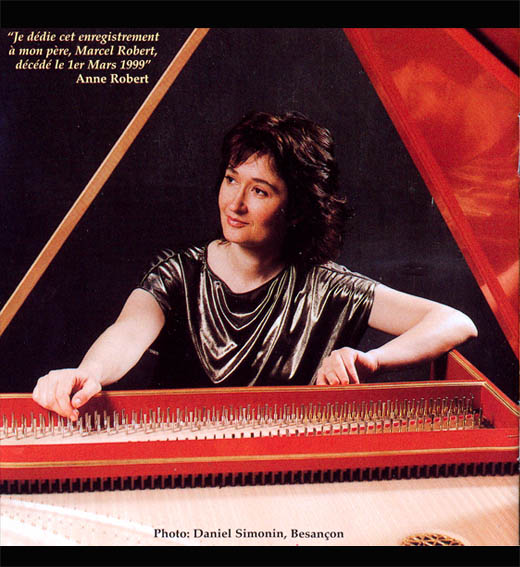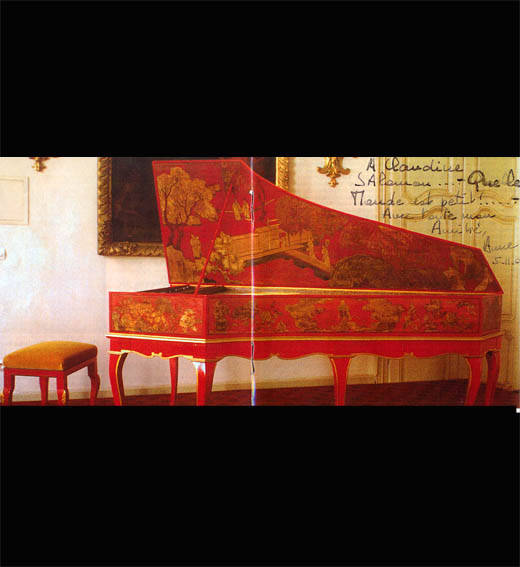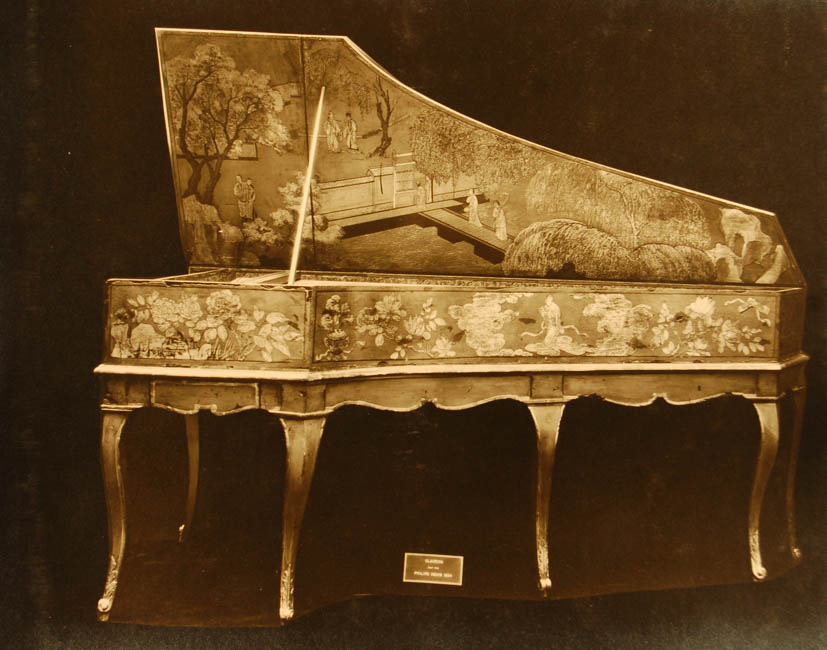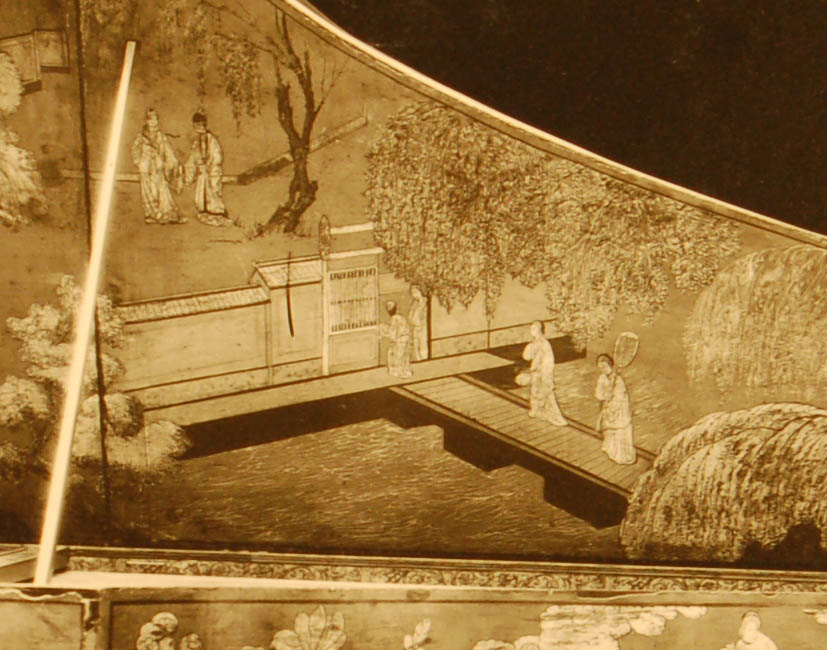I_25 Le clavecin de Philippe Denis (1674)
C’est le premier clavecin de la collection du Berceau Royal dont je retrouve la trace sonore !
Ce clavecin est sorti des ateliers Denis sous le règne de Louis XIV. Les membres de cette célèbre dynastie de facteurs apposaient tous, à la sanguine sous la table d’harmonie, leur signature ainsi qu’un pentagramme, figure géométrique intégrant le nombre d’or dans sa construction.
Des quatre clavecins Denis qui subsistent à ce jour, c’est le seul en état de jeu. Sa restauration, dont Daniel Ruf a accepté la responsabilité, a permis de le choisir pour l’enregistrement des Douze fantaisies de Telemann réalisé par Anne Robert en mars 1999 à l’Abbaye Saint-Colomban (Haute Saône).
La caisse, aux éclisses de noyer, était à l’origine peinte en noir, tandis que le des-sous du couvercle et la console l’étaient en rouge brique, seules couleurs autorisées aux « luthiers » par les règles de leur corporation. Le clavier comportait une octave courte avec une feinte brisée sur le ré. La table d’harmonie, décorée à la française, est ornée d’une rosace en parchemin qui a survécu.
Au XVIIIe siècle, le piétement d’origine a été remplacé par un piétement Louis XV plus au goût du jour. A la même époque sans doute, un petit ravalement a été effectué: ajout de deux cordes au grave et à l’aigu, ce qui a permis la suppression de l’octave courte et le passage du diapason 392 à 415 Hz. Il a été également redécoré de « laques à la manière de Chine » alors très à la mode.
Au XIXe siècle, l’instrument a subi un abandon prolongé. Il semble avoir servi de bougeoir, table à repasser, cendrier, sup-port pour pot de fleurs. Il en porte en tout cas les stigmates.
Au XXe siècle, notre clavecin se retrouve dans la collection Salomon; mais ne jouant plus, il est confié aux Frères Masson en 1922 pour une restauration qui ne semble pas avoir été couronnée de succès, car d’après mes observations, ils n ‘auraient pas diagnostiqué, sous le placage, un sommier fendu sur toute son épaisseur.
Mis en vente chez Drouot en 1934, vraisemblablement comme meuble décoré, le Denis est acquis par un maître de forge lorrain et il enrichit alors les collections du Château de Montaigu, actuellement géré par le Musée Lorrain à Nancy.
(d’après l’article de Daniel Ruf extrait de la pochette du CD
This harpsichord came from the work-shop of the Denis family during the reign of Louis 14th. Each one of this long line of famous harpsichord makers, at the same time as signing their name with red chalk underneath the soundboard would draw a pentagram, a geometric figure encompassing the golden section within its form.
Of the four harpsichords that remain today, this is the only one in working order. The restoration of this instrument the responsibility of which Daniel Ruf undertook enabled it to be chosen for this recording of the dozens of Telemann Fantasies, by Anne Robert in 1999, in the Saint-Colomban Abbaye.
The case with its walnut sides was originally painted in black whereas the underneath of the lid and the console were painted in brick red, the only colours the stringed instrument makers were allowed to use by their guild. The keyboard consisted of a short octave with the addition of a split sharp on the D sharp. The soundboard decorated à la française was embellished by a parchment rose which had survived the years.
In the 18th century the original harpsi-chord stand has been replaced by one of the more fashionable Louis 15th type of stand. Possibly during the same period, a small « ravalement » was carried out: the addition of two strings both in the base and the treble clefs allowed the elimination of the short octave and also the change in tuning from 395 to 415 Hz. As well as this, it was recoated and lacquered in the then very fashionable Chinese style.
In the 19th century the instrument was abandoned for quite a some lime. It appeared to have been used as a stand for candles, as an ironing board, an ashtray and a flower pot holder. The stains and the marks are there to prove it.
In the 20th century, we now find our harpsichord in the Salomon collection being no longer in working order, it was entrusted to the Masson Brothers in 1922 for a restoration which appeared not to have been successful. From my observation, they did not seem to have detected under the veneer that the thickness of the wrest plank was split right through.
Taken to the auction house of Drouot in 1934, seemingly a decorated piece of furniture, the Denis harpsichord was acquired by the owner of an iron works in Lorraine. It then enhanced the collections of the castle of Montaigu, these days managed by the Lorraine Museum of Nancy.
(according to Daniel Ruf, translated by Nicole Wrixon)
Dieses Cembalo entstand in der Werkstatt Denis, zur Zeit der Regierung Ludwigs XIV . Die Angehörigen dieser berühmten Dynastie von Cembalobauern pflegten unter dem Resonanzboden in Rötelzeichnung ihre Signatur zu hinterlassen sowie ein Pentagramm, geometrische Figur, die « goldene Formel » seiner Konstruktion enthaltend.
Von den vier noch existierenden Cembali Denis ist dieses das einzige spielbare. Dank seiner Restaurierung, dessen Verantwortung Daniel Ruf übernommen hat, wurde es in März 1999 bei Anne Robert für die Aufnahme der Zwölf Telemann Fantasien ausgewählt.(Abbaye Saint-Colomban -Haute Saône).
Der Resonanzkasten, mit seinen Stegen aus Nußbaum, war ursprünglich schwarz, die Deckelunterseite und die Konsole dagegen zie-gelrot gefarbt, dies waren die einzigen von den Regeln der Zunft erlaubten Farben. Die Klaviatur verfügte über eine kurze Oktave mit einer gebrochenen Obertaste « dis ». Der im französischen Stil dekorierte Resonanzboden ist mit einer Pergament-Rosette geziert, die die Jahrhunderte überlebt hat.
Im 18. Jahrhundert wurde das ursprüngliche Untergestell durch ein anderes im Stil Louis XV ersetzt, der damaligen Mode folgend. Wahrscheinlich wurde zur gleichen Zeit eine kleine Erweiterung ausgeführt. Es wurden im Baß und im Diskant zwei Saiten hinzugefügt. So konnte auf die kurze Oktave verzichtet und die Veränderung des Kammertons von 392 auf 415 Hz ermöglicht werden. Das Instrument wurde außerdem neu dekoriert mit « chinesischer Lackarbeit », zu jener Zeit sehr beliebt.
Im 19. Jahrhundert erlitt es eine lange Vernachlässigung. Es scheint als Kerzenhalter, Bügelbrett, Aschenbecher und Untersatz für Blumentöpfe gedient zu haben. Jedenfalls hinterblieben die entsprechenden Narben.
Im 20. Jahrhundert befindet sich das Cembalo in der Sammlung Salomon. Da es nicht mehr spielbar ist, wird es 1922 den Freres (Brüdern) Masson für eine Restaurierung anvertraut. Diese scheint aber mißlungen zu sein. Nach meinen Beobachtungen hat man damals nicht herausgefunden, daß der Stimmstock unter dem Furnier durchgehend gespalten war. Bei Drouot 1934 versteigert, vermutlich als Ziermöbel, wurde unser Denis von einem lothringischen Schwerindustriellen erworben. Es bereicherte daraufhin die Sammlung im Schloß von Montaigu, heute vom Musee Lorrain in Nancy verwaltet.
nach Daniel Ruf (Deutsche Übersetzung: Stefanie Delva)
